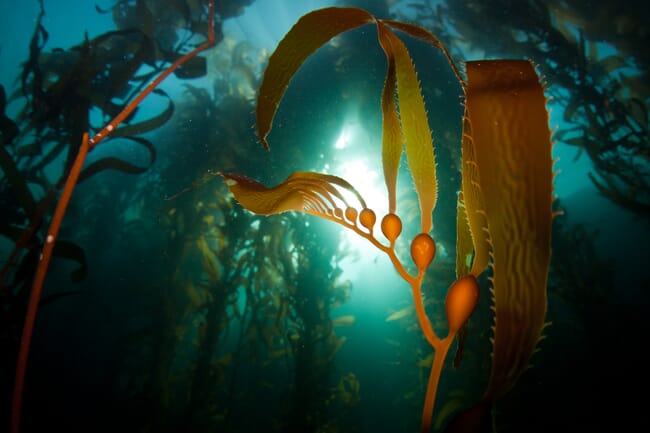
Previous studies have theorised that the improved seaweed biomass yields seen in integrated multi-trophic aquaculture (IMTA) experiments can be attributed to nutrient levels in the water – but results from a trial recently published in the journal Aquaculture suggest that the yield improvements are due to higher light levels instead of nitrogen concentrations. The study, which established a kelp farm next to a blue mussel farm in Sweden and compared it to a control site, found that the mussels’ biofiltration abilities made the water clearer and led to improved biomass yields and pigment concentrations in the seaweed. Integrating kelp and mussel production also led to a significant decrease in biofouling – allowing better-quality kelp to flourish to the harvest date.
When sugar kelp at the experimental site was grown between 1 to 2 m below the surface water, the researchers noted a 22 percent length and 38 percent biomass gain when compared to kelp grown at the control site away from the mussels. The team also noted that kelp had decreased epiphyte coverage and higher photosynthetic pigment concentrations when compared to the control.
Though this trial is an additional confirmation of integrated aquaculture’s ability to deliver on food production and environmental sustainability goals, it also demonstrates that there are factors beyond nutrient enrichment for IMTA practitioners to consider. It may take more than nutrient-rich waters for seaweed co-culture projects to thrive.
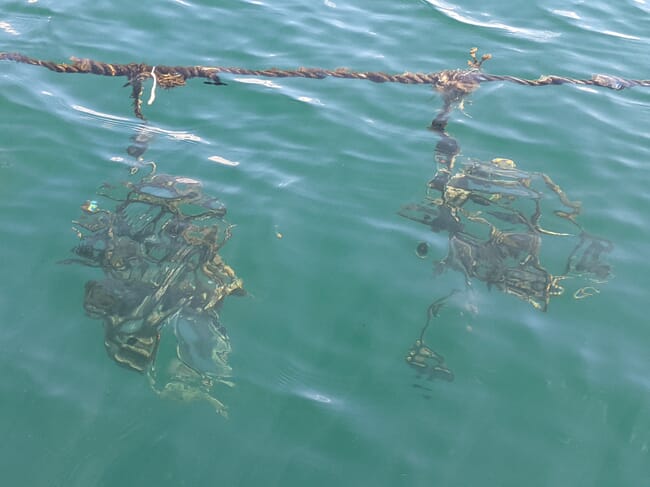
© Isle of Skye Mussels
The different types of IMTA
The vast majority of IMTA systems combine fed aquaculture species like commercial finfish and crustaceans with lower-trophic species like seaweed. In these systems, seaweeds absorb the nitrogen and phosphorous wastes from the fish and sequester the excess nutrients in the water, stemming off environmental degradation. When deployed strategically, IMTA can diversify farm yields and deliver ecosystem benefits like improved water quality.
More recently, IMTA practitioners are trying to create a zero-input and completely extractive method for producing food and improving the farm environment. Instead of using finfish, producers are turning to bivalve species like blue mussels as a protein source. Blue mussels are a promising addition to IMTA systems because they provide a net nitrogen uptake as they filter nutrients from the water. However, bivalves also produce their own metabolic wastes, elevating levels of dissolved inorganic nitrogen in the water. To counteract this, practitioners are integrating sugar kelp and blue mussels to capitalise on the nutrient load.
Integrating blue mussels and sugar kelp could yield other production benefits, especially in terms of biofouling. In seaweed farming, biofouling refers to the growth of organisms on the seaweed plant. These organisms – called epiphytes – grow on the seaweed blades and prevent the seaweed from filtering the water. They can also hinder the seaweed’s growth. Since mussels already act as strong biofilters, there’s reason to believe that they could filter the larvae and spores of fouling organisms from the water. Thus far, there have only been a few co-cultivation trials with kelp and blue mussels. These tended to demonstrate the feasibility of co-cultivation. Researchers haven’t focused on the potential biomass yields of kelp in the system, or whether the mussels could keep epiphyte levels low.
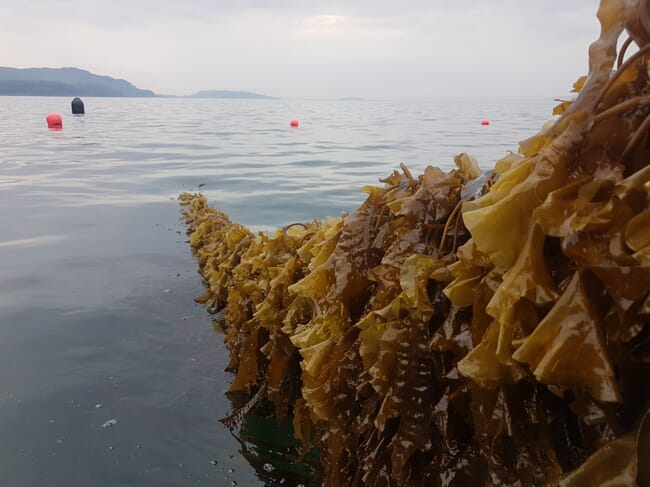
© Shore Sugar Kelp
The site and trial set-up
The researchers conducted the study near a commercial mussel farm off the coast of Mollösund, Orust in the West of Sweden. The mussels were grown on ropes – with ten 200 m longlines spaced at 1 m intervals. The mussels at the site were within 1 to 2 years old and were held in dense aggregations.
The team then suspended adult kelp sporophytes 10 m downstream of the commercial site. They also installed kelp lines and 500 m away from the farm as a control site. The seaweed was held beneath the water’s surface at two depths: 1 to 2 m under water or 3 to 4 m under water. The researchers used submersible light loggers to track the light intensity values for 10 months. At the end of the period, the team sampled the kelp lines for their biomass, epiphyte numbers, pigment quantification and elemental analysis.
The benefits of co-cultivation
Initial results of the trial showed a notable benefit in growing kelp alongside blue mussels, especially at 1 m depth. Seaweed yield and quality was stronger in this system and at this depth than in the monoculture control site. The researchers noted that kelp lengths at the experimental site were 22 percent longer than those at the control site and biomass volumes in the co-culture group were 38 percent larger. Growing the kelp near the mussels decreased epiphyte coverage by 54 percent and was associated with significant increases in photosynthetic pigment concentrations.
The researchers believe that the recorded improvements in growth and pigment levels can be attributed to the increased light clarity and intensity downstream of mussel farms. They found that nitrogen enrichment didn’t drive kelp growth at the different water depths, or at the control and experimental sites. In their analysis, they noted that the filtration effect from the bivalves made the water clearer, allowing more uninterrupted photosynthetic exposure. This increased light exposure had multiple downstream effects that enhanced kelp production.
The mussels’ biofiltration effect was noted in the reduced epiphyte coverage at the experimental sites. In this case, kelp at the monoculture site showed 15 percent epiphyte coverage, while kelp grown at the IMTA site showed 6 percent coverage. The researchers theorised that the bivalves removed potential biofouling species out of the water column. This reduced the quantity of larval or spore hydroids and bryozoans in the farm environment, and prevented them from colonising the kelp blades. The researchers also note that the biofiltration kept levels of opportunistic algae in check, maintained nutrient levels as the kelp grew and kept the water clearer. This wasn’t the case at the control site. The lack of bivalve filtration led to higher recorded epiphyte concentrations and lower biomass.
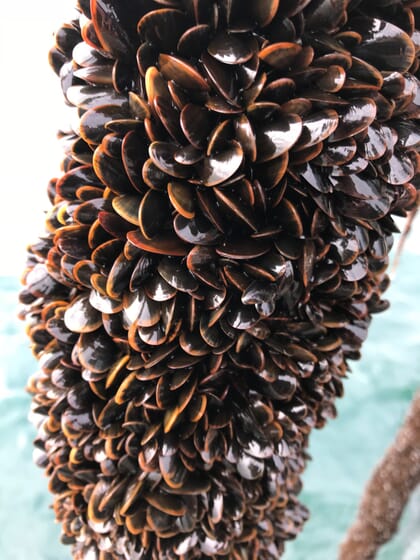
The researchers also postulate that the increases in kelp pigmentation and bioactive compounds at the IMTA site can be attributed to the presence of the mussels. Though other studies showed that photosynthetic pigments like chlorophyll, fucoxanthin and phaeophytin decrease with higher light irradiances, this trial had the opposite pattern. This suggests that kelp at the experimental sites could utilise the nitrogen excreted by the mussels – even though the co-culture environment did not have high nutrient levels.
Key conclusions
The observed growth and biomass dividends for the kelp along with the reduced epiphyte levels are a promising result for non-fed IMTA systems. It appears that the co-culture approach addresses two frequently recurring issues in kelp aquaculture: biofouling and nutrient limitation.
Culturing both sugar kelp and blue mussels simultaneously allowed the bivalves to filter biofouling organisms from the water and provide the kelp with an additional source of nitrogen – giving them a lifeline if water conditions changed. It also appears that the improved water clarity and light availability stemming from bivalve filtration had a positive impact on kelp growth and quality. This indirect effect produced kelp with enriched bioactive compounds and higher pigment concentrations.
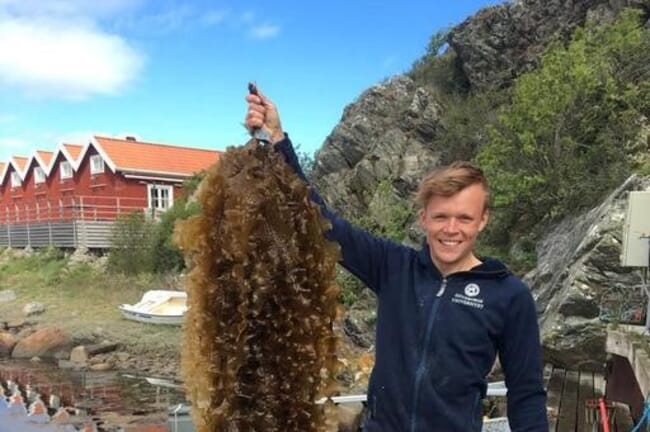
The researchers stressed that the co-culture method had to be refined. The team used submersible light loggers and underwater seaweed lines for the trial – this may not be the most efficient way to produce kelp. Despite this potential limitation, the researchers note the trial presents a compelling case study for fully extractive IMTA models.




